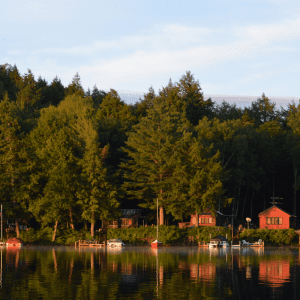Cabin Season and HVAC
 Cabin season is a time of year we all look forward to. Hours in the woods, or for those fortunate to be on the water, hours of swimming in a beautiful lake. Owning a cabin is not for the faint of heart, it comes with hours of chores to open up for the year, close down for the season, and regular trips to ensure the cabin is in working order. The type of HVAC in your cabin can mean extra maintenance and added chores.
Cabin season is a time of year we all look forward to. Hours in the woods, or for those fortunate to be on the water, hours of swimming in a beautiful lake. Owning a cabin is not for the faint of heart, it comes with hours of chores to open up for the year, close down for the season, and regular trips to ensure the cabin is in working order. The type of HVAC in your cabin can mean extra maintenance and added chores.
If you’re building a new cabin, renovating your existing cabin, or simply dreaming of things that could be, there is a lot to consider before you decide how to heat it. The fuel source you’ll utilize is the first major consideration to take into account. Think about your area, the goals of your cabin, and how remote vs relaxing you’d like to be. If you are off grid, your options are a lot more limited than if you have utility access.
Small cabins have small heating needs. If you’re looking at a smaller space that isn’t going to be inhabited during the winter, then you may only need a wood burning fireplace. These are simpler heating solutions that require a good chimney scrubbing occasionally, but convenient and with proper care require little maintenance.
A heat pump is another great option for a smaller sized cabin that will only be visited during warmer seasons. The pumps do well in the late spring, summer and fall, but are not meant for the cold Minnesota winters. If you plan on only visiting in the warmer seasons, a heat pump could be a cost effective and easy way to warm your cabin. There are also options for stand-alone units that can assist in heating a small space, while not breaking the bank. These include direct vent furnaces, and vent free convectors. Equipment such as these will heat areas you anticipate need it most, like bathrooms or bedrooms, while leaving less trafficked areas cooler and saving you money.
Another great alternative option to conventional furnaces is the condensed furnace. A traditional conventional unit generates exhaust at much higher temperatures than the exhaust from a condensed furnace does. Condensed furnaces pull as much energy, or heat, from their exhaust as possible, making them energy efficient and cost effective.
Radiant heated flooring is one of the most popular selections for cabin heating, especially in cooler climates. Warm water is pumped through piping in your flooring that assists heating your space with an added bonus of warm floors. This option is especially popular in the north woods, and less so as you travel towards warmer climates.
The options listed above are great alternatives to a conventional heating system for smaller spaces. The larger the cabin, the more straight forward your heating solutions become. Conventional systems are popular for a reason, but have options to supplement with any of these items, and sometimes a variety of systems work best for your space.
If you are looking to change up the HVAC in your cabin home, it’s important to consider things like what is available in your area, how many people you intend on hosting and how often you expect to use the space. There are so many options when it comes to heating a residence, it is important to be informed before you buy. If you have any questions about how best to heat your cabin, give us a call!
https://www.hvac.com/blog/a-guide-to-log-cabin-heating-and-cooling/
https://www.cabinlife.com/articles/article/heating-and-cooling-your-cabin
https://surefireinc.com/hvac-system-for-your-cabin/


























